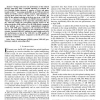Free Online Productivity Tools
i2Speak
i2Symbol
i2OCR
iTex2Img
iWeb2Print
iWeb2Shot
i2Type
iPdf2Split
iPdf2Merge
i2Bopomofo
i2Arabic
i2Style
i2Image
i2PDF
iLatex2Rtf
Sci2ools
CORR
2008
Springer
2008
Springer
On Outage and Error Rate Analysis of the Ordered V-BLAST
Outage and error rate performance of the ordered BLAST with more than 2 transmit antennas is evaluated for i.i.d. Rayleigh fading channels. A number of lower and upper bounds on the 1st step outage probability at any SNR are derived, which are further used to obtain accurate approximations to average block and total error rates. For m Tx antennas, the effect of the optimal ordering at the first step is an m-fold SNR gain. As m increases to infinity, the BLER decreases to zero, which is a manifestation of the space-time autocoding effect in the V-BLAST. While the sub-optimal ordering (based on the before-projection SNR) suffers a few dB SNR penalty compared to the optimal one, it has a lower computational complexity and a 3 dB SNR gain compared to the unordered V-BLAST and can be an attractive solution for low-complexity/low-energy systems. Uncoded D-BLAST exhibits the same outage and error rate performance as that of the V-BLAST. An SNR penalty of the linear receiver interfaces compare...
| Added | 25 Jan 2011 |
| Updated | 25 Jan 2011 |
| Type | Journal |
| Year | 2008 |
| Where | CORR |
| Authors | Sergey Loyka, François Gagnon |
Comments (0)

